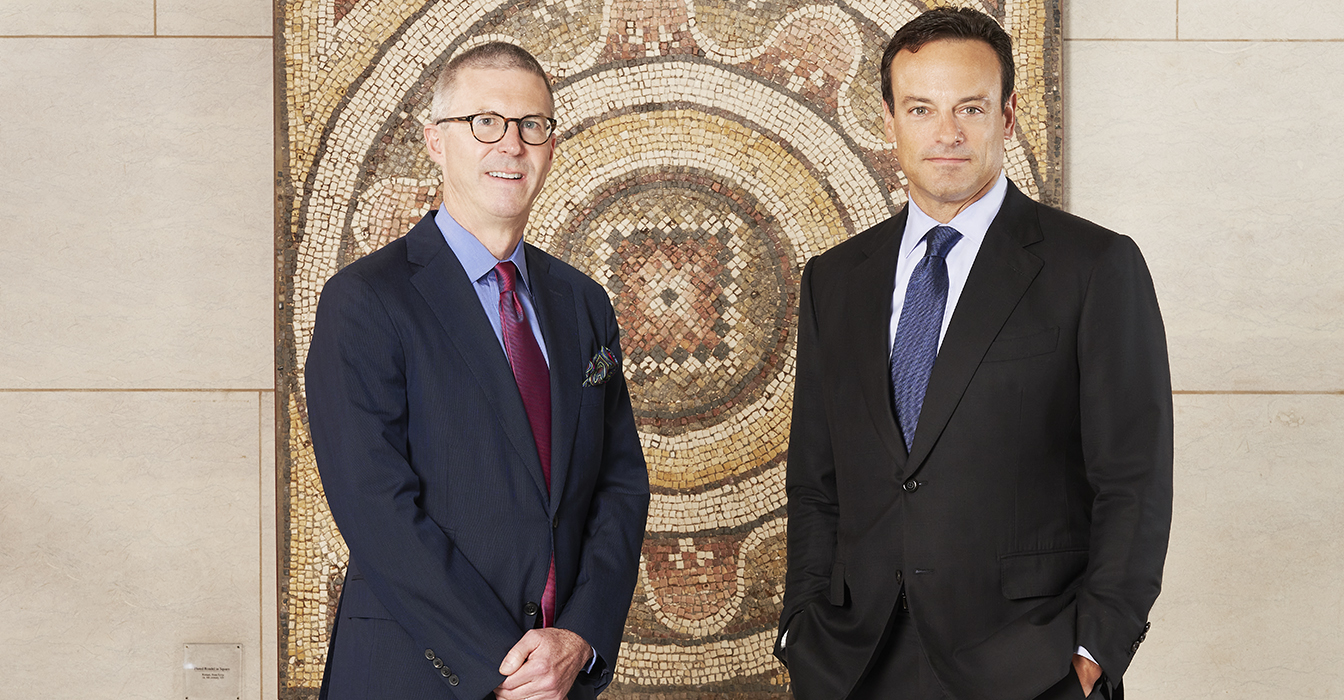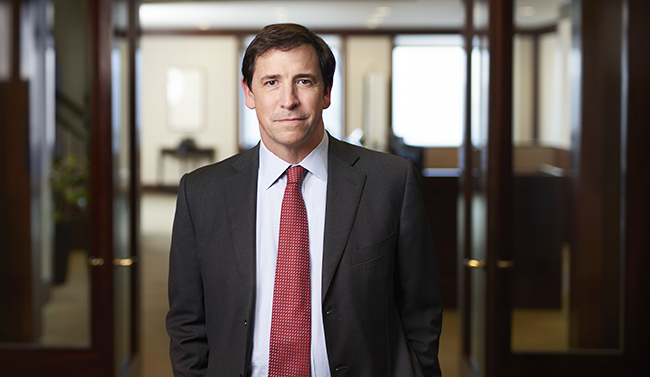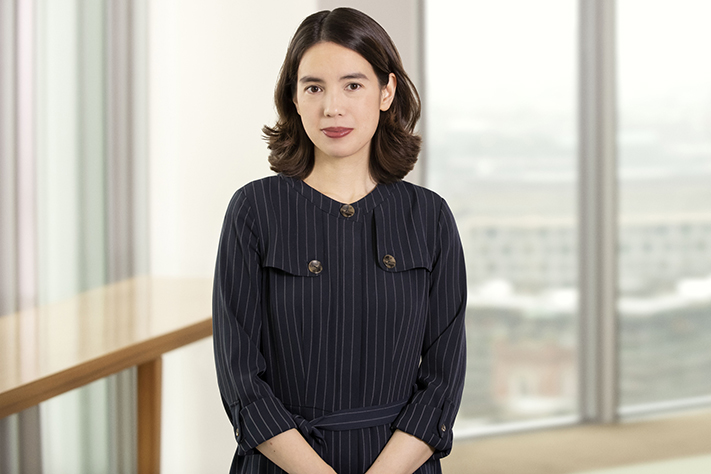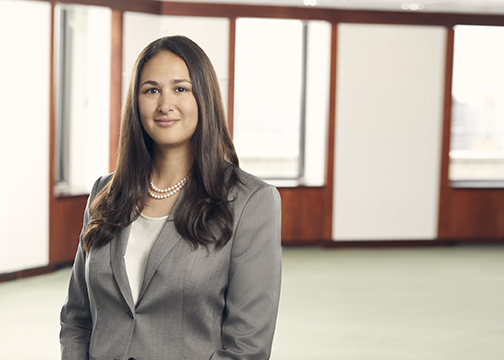A Pandemic, a Hot Market and “All Systems Go” for Cravath’s Capital Markets Team
By Katrina Dewey | October 30, 2020 | Law Firm Roundtable, News & Features, Cravath Features, Dealmakers

Photo of Andy Pitts and Craig Arcella by Laura Barisonzi.
Dealmakers everywhere had reason for high hopes as they greeted Jan. 1, 2020. The stock markets were at all-time highs, public offerings were in the chute and the horizon looked clear – save for a high-stakes presidential election coming in the U.S.
The global pandemic plunged worldwide economies to new depths, with lockdowns debilitating travel and retail, as well as restaurants and other hospitality and event businesses. Small businesses have been massacred.
The world’s largest corporations and investors have faced a different array of challenges, assessing risk, liquidity and the future of their businesses in the most uncertain of times. And so too have their lawyers at Cravath.
Early this fall, Lawdragon discussed the trajectory of the pandemic and its impact on the markets in the U.S. and Europe and the outlook for year-end with members of Cravath’s top-tier Capital Markets team: Andy Pitts, the New York-based head of the practice for North America; Sasha Rosenthal-Larrea, a New York partner whose practice also covers leveraged loans; Craig Arcella, also in New York, and Co-Head of the Firm’s Finance Practice; Alyssa Caples, based in London, whose practice also includes corporate governance and board advisory work; and Philip Boeckman, also in London, where he is both the Managing Partner for the office and Co-Head of the Capital Markets Practice for EMEA (Europe, the Middle East and Africa).
Despite a global economy that nearly ground to a halt, the Cravath Capital Markets team has had a white-hot year. The activity is thanks, in part, to the firm’s generalist nature, showcased by its breadth in representing both corporate issuers and investment banks, and allowing it to pivot from high-yield bonds to equity finance at a moment’s notice.
Lawdragon: How would you describe the impact of the pandemic on Cravath’s capital markets practice?
Andy Pitts: There has surely been an evolution over the past several months. Companies in sectors like oil, aerospace, travel and retail determined relatively quickly following the onset of the market panic that they needed to raise capital. And it was not necessarily because they weren’t going to be able to pay the bills in a week or even in six months, but because there was such severe dislocation that even really well-capitalized, large, more mature companies wanted to put more cash on their balance sheets.
One of the simplest ways to do that was for a company to borrow everything it could under its revolving credit facilities. A lot of companies across the credit spectrum have revolving credit facilities that are largely unused by the higher-rated credits, but they’re available as a security blanket. So our team at Cravath spent a lot of time in March and early April talking to corporate clients about that decision in the early months: “Should we draw down the revolver?” At that time, the thought was, “If we don’t do it today, is it possible that in two weeks, the banks won’t let us?”
There was a fair amount of activity along those lines early on, but then the Fed intervened very aggressively in the credit markets.
LD: That’s interesting, as I think much of the focus in the non-financial media was around the halt in M&A activity.
AP: That changed too, certainly. On the financing side, equity markets stabilized, but I think – more importantly in many respects – the bond market stabilized at very low interest rates.
The next phase we saw was industries that weren’t severely impacted by the pandemic looking at the market and saying, “Even if I have to pay a little more because of some volatility in the market in terms of credit spread, I can still borrow at all-time low rates.” That drove a lot of financing activity.
LD: What were some of the other changes that became more pronounced as things progressed?
AP: Going into April, May and then June, we were seeing enormous volume in investment-grade issuance and, as the market digested that, we started to see more people creeping into the market further down on the credit spectrum.
The third element of the pandemic trajectory that certainly impacted our work was an incredible uptick in the convertible debt market. If you think about the economics of convertible debt, it’s basically a forward sale of your common stock, and you’re selling it at a premium to the prevailing market price. So in the spring and into the summer, even though the markets recovered, there were still a lot of companies in the more impacted industries whose stock might have been off 25 percent or 30 percent, but they could go out and raise convertible debt with a conversion premium of 35 percent on the common stock. Many issuers used derivative products to increase the effective conversion rate to significantly higher premiums. It was an attractive option – particularly given there is virtually no corporate CFO that thinks his or her company is overvalued.
LD: Was it the same situation operating out of London?

Philip Boeckman: We experienced a similar situation in Europe, though with a few wrinkles. One was that at least some of the bigger corporates were able to avail themselves of government funding, which reduced some of the balance sheet needs they had arising out of the pandemic. There was still a role for capital markets to play there, but the state aid helped to bridge some of that gap.
There’s also a greater tendency in Europe, at least in some jurisdictions like the UK, to turn to the equity markets and existing shareholders to raise financing when in need. So we’ve certainly been quite busy on some of those follow-on or secondary equity offerings by existing public companies in the UK and other jurisdictions. In terms of the high-yield bond market, while that recovered and came back to life quite quickly in the U.S., it took a little longer in Europe, as it normally does, for it to bounce back. But once it did, which was really by May, it has been quite busy.
For example, we completed at the end of July a debut high yield issuance for a payment services tech company, Paymentsense Limited, and they raised £290M in an all-sterling deal – the largest of the year. So it’s been interesting to see how quickly the high-yield market has recovered.
LD: Let’s talk a bit more about the high-yield bond market specifically. Cravath has been a leader here since helping to develop it in the '80s. What changes have you seen in the last several months in the high-yield space in particular?
Sasha Rosenthal-Larrea: As soon as it became very clear that things were going well in the investment-grade markets, a lot of the high-yield issuers piled on, mostly to add capital to their balance sheets. That was followed by a strong wave of opportunistic refinancings.
One thing that we’ve seen is that there’s a huge uptick in the proportion of high-yield bond offerings that are secured. Secured notes used to be few and far between in the U.S. In Europe, it’s much more common for them to be secured. So in the face of the pandemic, and amidst all of the related uncertainty, to improve execution, a lot of issuers chose to go out with secured offerings, which introduce additional complexity.
Alyssa Caples: On the high-yield side in Europe, we had many transactions that were put on hold at the beginning of the pandemic. There was a lot of start and stop, and it hasn’t been a smooth market for all issuers. Depending on the market you’re in and depending on how picky a company may be about terms, there is still some choppiness in the high-yield market. That said, in the last month or so, the high-yield market in Europe has really picked up and we’ve been quite busy with a number of deals that have launched and priced.
LD: So there is volatility, too, in terms of some of the financings: they’re not completed, the companies choose not to do them or can’t do them on the terms that they want. Does that require more work by you as counsel to help a client arrange options?
PB: Yes, you can especially see that on the high-yield side. For issuers, being flexible and versatile and ready to go at the right time is especially important.
AP: Basically, you have investment banks encouraging issuers to be ready, have the documentation in place and then it’s the trial balloon approach, where they’ll say, “Oh, one of your comparable companies, or one of your peers, is going to go to market next week and let’s see if they can get a deal done.” For the most part, in my experience, it has been less whether an issuer can get a deal done as opposed to at what terms it can be done.
PB: On top of it now, of course, you have the U.S. election. Obviously, for the IPO market in particular, but even for the bond markets, everybody is trying to get deals done sooner rather than later on the assumption that, as we get closer to November 3rd, there may be too much market volatility and a bit of a blackout.
LD: That is very much a global consideration, and I want to pivot to that point – how Cravath’s practice is integrated across offices. Can you talk about how the team works together out of New York and London, particularly now given the state of global markets?
Craig Arcella: The relationship between our New York and London offices is really a unique combination of independence and collaboration. Obviously, New York is Cravath’s center of gravity, but the London office has always been a true leader in European high-yield and U.S.-bound European equity issuance and also has a number of active investment grade issuer clients. We work very closely together through all market cycles. Importantly, all of the capital markets partners in London began their Cravath careers in New York, and a number of the New York-based capital markets partners (including Sasha and me) have spent considerable time working in London. So, while the London and New York offices are independent practices with their own client bases, we are constantly collaborating and covering global clients as a team. That works extremely well in today’s environment.

AC: Particularly in today’s financing environment, corporate clients often have a wide range of products to choose from. With offices in both New York and London, Cravath is able to offer our clients products in both markets. For instance, I routinely work with Tatiana Lapushchik, another of our New York-based finance partners, on transactions for clients where they seek to access both the European high-yield market and the U.S. leveraged loan market. The collaboration creates a lot of cross-fertilization – we are able to bring our clients a broad perspective and update them on trends in each market so they have the opportunity to access the “best of both worlds” for the terms of their instruments.
LD: The perspective Cravath brings from a global, market-leading practice gives each of you remarkable insight into the range of discussions happening in organizations of all types and sizes and the options they are formulating through this period.
AP: We work a lot with investment banking clients, and investment bankers are focused on solutions. But for a lot of our corporate clients, they have less experience evaluating the relative advantages and disadvantages of all the different products out there. One of the things we do is help them understand the advantages and disadvantages and the cost of those options, such as secured high-yield bonds. Companies that take that option, for example, will be precluded from using those assets as collateral in other types of financing later. So, while it may sound good today, this is a seven-year, a 10-year instrument, and it’s going to have implications for life. A big part of our job is making sure clients don’t just focus on the near-term benefits, but are in a position to make thoughtful decisions about the longer-term consequences.
LD: Right. It’s vital to underscore that the choices clients make today, even in these circumstances, they’re going to be living with when markets are good and the world is presumably better.
PB: That’s right, and we’re having different conversations with clients who were in different positions pre-pandemic.
The consumer-facing sectors have been particularly hard hit. How they have approached capital market solutions through this period has depended on their company’s specific situation heading into the pandemic.
Those companies that had stronger balance sheets, that had to raise financing and maybe turned to the equity or debt markets, they’ve been able to do that and stabilize their business and move on. So we’ve done that for issuers in the hotel industry, issuers in the business of fashion, sports betting, soccer clubs.
Those companies that were already on shakier ground had to pivot to more of a restructuring mode when the pandemic hit. For example, our team in London, together with Paul Zumbro, a restructuring partner in our New York office, advised a Dutch retailer in a restructuring process with a debt-for-equity swap and new debt instruments, completing a UK scheme of arrangement, emerging from the restructuring process and keeping the business intact and jobs in place.
There were many companies facing headwinds before the pandemic, and then the pandemic obviously accelerated things to some extent.
LD: It certainly seems that many of the companies that filed bankruptcy in the U.S. were already deeply troubled. And most were in a deeply challenging sector.
AC: Relatedly, another area that has been interesting in the capital markets space through the pandemic has been disclosure and how a company signals how the business is doing. This was especially true in the beginning, when only 2019 financial statements were available and none of the pandemic’s impacts had yet appeared in publicly-available numbers.
Finding ways to evaluate what was happening to a business during the onset of the pandemic and really kicking the tires and putting that into words to inform investors when the hard numbers weren’t available was a particularly interesting and somewhat challenging exercise. It meant going through each business and really digging into and understanding, “What is the impact? Where are the soft spots? What do we see coming down the pike?” and turning those insights into appropriate disclosures.
LD: That’s fascinating because certainly there was that moment in the spring of suspended animation – where, as you say, nobody knew anything about the impact and you were having to figure out, based on numbers from a prior world, what to say.
AP: The expectations really evolved a lot, too, because on March 15th, it was acceptable to be vague about the changing markets and growing impact of the pandemic. But on April 15th, the market wouldn’t accept that anymore, and it was expected that disclosure was going to be more comprehensive and telling.

SRL: We saw that in a bond offering for an airline parts manufacturer, which priced at the beginning of April, and so you can imagine that when we started working on it, we had to start from scratch given there was no first-quarter 10-Q filing out there with a Covid-19 disclosure.
The issuer pulled their existing guidance the morning that we launched the bond offering. It was interesting to be on the ground and involved in preparing the company’s disclosure relating to Covid. At that point, we really had to look at disclosures that had been made in the issuer’s 10-K filed in February and analyze what needed to be said, and whether things need to be updated. It wasn’t just a matter of putting together one paragraph on the Covid risk factor and moving on.
LD: What about the leveraged finance space? What have you seen in the past few months?
SRL: What was happening amidst the pandemic was companies were looking to amend their credit facilities, particularly their financial covenants. Those amendments, though, came at a price, not just financial but also in the form of reduced optionality for the company.
What has also been interesting is that acquisition finance disappeared for about three months. I spent a lot of time on opportunistic refinancings and cash-to-balance-sheet transactions. It was very odd to take a break from the acquisition finance space for a while, but that work started up again about two months ago, and we seem to be off to the races in only a slightly more subdued way than we were earlier this year.
Another deal that I worked on recently was representing one of the major investors in a cruise line participating in a financing for the cruise line early on in the pandemic. We worked with the shareholder who was looking to become involved for the first time on the debt side in order to protect their equity investment, so that was very interesting and detail-oriented work.
CA: In addition to the credit agreement amendments that Sasha refers to, at the outset of the pandemic we saw two other workstreams in the leveraged finance space. First, there were a lot of M&A deals that had been signed pre-pandemic but where the financing was yet to be raised when Covid hit. Getting those deals closed was tricky and required careful analysis of the pre-pandemic contracts in order to find as much flexibility as possible. Second, there were a lot of credits that quickly went into distress, and our ability to develop creative liability management solutions became increasingly important.
Since that early period, there has been a relative return to normality, as banks have been willing to commit funds to credits whose story works within the current pandemic-affected economy. It’s been encouraging to see.
AP: In terms of nimbleness and flexibility, we talked about being ready to go and going to the market when the market is ready. In the high-yield or leveraged finance space, that’s especially true as it relates to what you bring to the market, and we see that a lot at Cravath just given the nature of our practice.
Once upon a time, issuers, with the advice of their lawyers and investment banks, made a decision, “We’re going to access the high-yield bond market,” and everybody would get on the bus and you drove it to the station. Or you decided, “We're going to finance this with a term loan or other credit facility product,” which is a different process.
Those were completely separate tracks and often had completely separate lawyers, whereas now you see a lot more agility and people saying, “Guess what, we’re not doing a secured bond deal anymore, we’re doing a secured term loan.” Or vice versa. Or “We’re going to split up. We’re going to do an unsecured bond and a secured bond.” For Cravath, where we are active in the high-yield market and where we have leading lawyers in the bank and bond arenas of the leveraged finance space, we all have the ability to say to our clients, “OK, if you want to make that toggle, I’m your lawyer,” which is tremendous. Our platform allows us to deliver in all of these areas, and to help our clients evaluate the best options for their business.
LD: The market activity seems almost a reflection of Cravath’s practice as you’ve described it.
AP: One of the benefits of our practice is that we are very flat and all of us grew up working on lots of different types of transactions. We don’t have 40 people who only know how to do high-yield bonds in Europe. If, for some reason, there’s a big pull back in that space, we don’t have enormous under-utilization of our lawyers. Our breadth of skill and the relatively small size of our firm historically has allowed us to deploy resources where they can be best used.
And in 2020, capital markets has absolutely been an area where we’ve had a lot of activity and focus within our Corporate Department. In many areas of the market – the convertible debt market, the IPO market, the investment grade market – there’s been more volume than in the year before and, in certain of those sectors, than in the largest prior year by volume.
LD: And, of course, there’s the election just around the corner. How much is that impacting your practice?
SRL: It’s just all systems go. Every day there is a new call from a client indicating they want to do a deal by mid-October. Mid-November is the cutoff in a typical year, but with the upcoming general election in the United States, timelines have all been accelerated.
The markets are really good. I’ve had clients who issued bonds at the beginning of the pandemic and some that have issued bonds recently, and, all things being equal, the interest rate is about half what it was six months ago. So the market is really hot right now, but of course it is difficult to envision what we may see in 2021.
PB: No one knows, of course, what next year will hold, though I’m sure there will continue to be periods of some volatility and this flexibility that we’ve talked about – both from our clients and our ability to pivot as advisors – will continue to be critically important. I think it will also be interesting to see what happens in the IPO market, which has been very strong recently with deals like Snowflake and the direct listing of Palantir, where we were involved. But with the valuations we’re currently seeing in the equity markets and the U.S. election, whether that market takes a pause or not remains to be seen.
LD: Palantir launched as a direct listing, an alternative to a traditional IPO. Another IPO alternative, SPACs [special purpose acquisition companies], have been getting a lot of attention recently. Are SPACs going to be an important part of Cravath’s capital markets practice?
CA: SPACs will clearly be a part of our practice for so long as they have the traction in the marketplace that they do today. Many of our private clients that are considering entry into the public markets, and many clients that are looking to divest a business where an IPO is a possibility, are today looking at the SPAC alternative. For Cravath, the option creates a great opportunity, because we can deliver unique value given our strength in M&A and our capital markets expertise. That said, because our capital markets practice is so diverse, I believe that SPACs will become a regular “part of the portfolio” rather than a discrete or particularly heavy practice area.
About the author: Katrina Dewey (katrina@lawdragon.com) is the founder and CEO of Lawdragon, which she and her partners created as the new media company for the world’s lawyers. She has written about lawyers and legal affairs for 30 years, and is a noted legal editor, creator of numerous lawyer recognition guides and expert on lawyer branding. She is based in Venice, Calif., and New York. She is also the founder of Lawdragon Campus, which covers law students and law schools. View our staff page.

